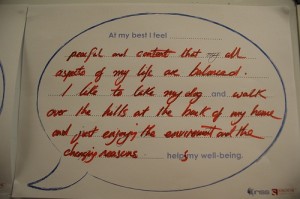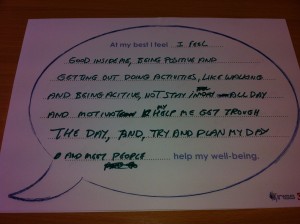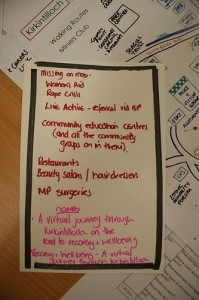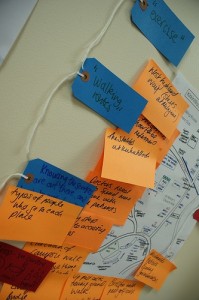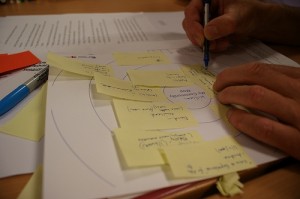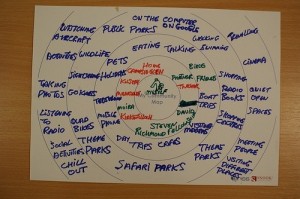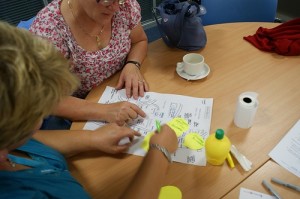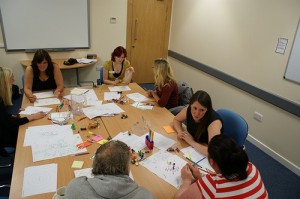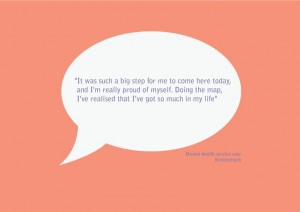The third and final workshop in the series focused on bringing together the ideas from the previous sessions, firming up the assets that we felt were important to map, and considering how we might (as individuals and organisations) use them better.
Who was there?
Because we were keen to work slightly differently at this workshop, we brought together a smaller number than the previous two sessions. This was important as we were keen to help people map their personal assets, which could be considered quite difficult to do in a large group. This meant that there was 10 people at the workshop (5 people who use services, and 5 who support people who use services).
What did we do?
1. What does well-being mean to me?
We worked together in two groups of seven people (including facilitators) to think about how we feel when we are well, and the types of things that we do to help us continue to feel this way. We wanted to capture this at the beginning of the session so that we could refer back to this when completing the other activities. We were keen to encourage people to be aspirational when completing their well-being statement.
Some of the statements looked like this:
The majority of people talked about ‘feeling good inside’, as well as feeling a sense of ‘calm’ or ‘relaxation’. It was interesting that many people talked about knowing themselves well enough to judge when they would need to take action to keep themselves feeling well, and when they did not.
The types of activities that people talked about doing to keep well were similar to those that had been discussed in previous weeks and centred around:
- connecting with others
- keeping busy, and having structure to your day
- feeling motivated was really important for both groups – knowing how to get motivated and what works for your was incredibly important
- knowing what services were available, knowing how to use them, when and how you could be referred was also talked about as being vital
2. Review of the map and generating ‘tags’
We worked together at this stage to review the community map so far and to think about what assets might be missing. It is amazing that whenever we bring together new groups of people to do this exercise the amount of new information that we learn and share!
Some of the new assets we mapped included:
- lots of walking routes
- german bakery
- 10 pin bowling
- rape crisis drop in centre
- live active exercise referral programme
- community education centres
- kelvin valley walkers
- categorizing supports in terms of the way you might feel when you have used them, e.g. ‘relaxation’, ‘confidence’, ‘motivation’ etc.
- we should have general tags like ‘exercise’ with the ability to choose from a range of options that follow.
- people thought that how to access services should be tagged – including things like ‘self referral’, ‘open to anyone’, ‘call or apply online’, ‘GP referral only’ etc.
- people also came up with a range of specific tag words to be used for the individual services.
- Encourage people who know that they need support, and consider what works best for them to try out new things.
- Help people who don’t know where to go, or explain how to get started on the road to better mental health and well-being
- Be of use to those who need the most support – with helpful phone-lines and ways to get in touch with people immediately.
3. Developing my community map
For the next activity we asked people to work in pairs to consider their own personal assets. We asked people to draw or write a map of all of the different affiliations or communities of people they belong to (including moral support, access, resources etc.) that they thought were useful for their well-being. We broke this down into three categories that are most important to them:
- People
- Places
- Activities
The maps looked a little bit like this:
We then asked people:
- What they noticed about their community map.
- If they’d learned anything that surprised them, or if they’d gained any insights.
- What was missing, and what would support them to use the assets in the community map (big map of Kirkintilloch) better.
In reality, every participant in the group was happy to complete their map. Moreover, they all commented, in one way or another, what a positive experience undertaking the activity had been for them.
4. Visualising data
In the last session after lunch, we talked about different ways of presenting the data and information we’ve been collecting over the past month. Participants were given a range of different examples of other online visualised maps from across the world.
We were asked people what was useful and not so useful about these different types of visualisations and what they felt would make them better for the purposes of this locality and in their area.
Some of the ideas that people came up with for the map included:
- focusing on personal stories of people with lived experience of using services in the area – through quotes or real stories
- making sure that there is a physical or printed copy that people have as well as an online version
- there was excitement for using a range of different categories to cover the different services
- a way to communicate different events (and the locations of those events) – like a prepared diary/calendar
- a way for organisations to communicate with one another
Reflections
This session was focused on bringing the community elements that we’ve been mapping back down to focus on individuals, and working with people to understand how they could use community supports more. We also wanted people to understand more about the outputs of the project and to have their say in its development and to have them consider how they could potentially use it.
The focus of the project has been on understanding whether or not an asset based approach could be applied to the field of mental health and how its use could reveal existing capacities within the community and in individuals.
I’ve been reflecting on the last session and I think its success was based on looking at people’s personal assets. It was incredibly powerful to see and hear people appreciating and being astounded at all of the different valuable things that they have in their lives and considering the steps that they could take to both strengthen what is there already as well as develop new networks and ties. It was an exceptionally rich process which created a lot of discussion.
This has a lot in common with the recovery based approaches that the service providers in the area are using to help people with mental health problems take control over their journey towards wellness. What we’ve hopefully achieved through this process, is to consider more creatively how providers can work together with people using services to consider how they understand themselves, their well-being and the support and services that might help them in the process of recovery.
I think the process that we’ve gone through over the past three weeks links quite neatly into much of the wellness and recovery action planning (WRAP) work that is already going on in a variety of different ways in the area. Hopefully the process, as well as being useful for the people who use services, has also given practitioners some more tools for their toolbox.
Perhaps the most thought provoking of all was that people recognised that their lives were quite full and that they hadn’t realised or recognised it for a while. The process has shone a light on the value of making things visual and working in 3D.
What’s next?
I’d just like to thank all of the people who have given their time, engery, ideas and enthusiasm by coming along to the workshops and sharing their experiences and knowledge. Truely, the project would not have been possible without you. I hope you are pleased with the end result!
Over the coming weeks, I’ll be working to qualitatively thematize the outputs from the four sessions. This will culminate in:
- A final report with recommendations and reflections for the local authority to consider
- A document that outlines the project process, including step-by-step guides and reflections on what went well, and what did not go so well
- A couple of visualised examples of what the final project output could look like for key stakeholders to consider, develop and agree upon.
